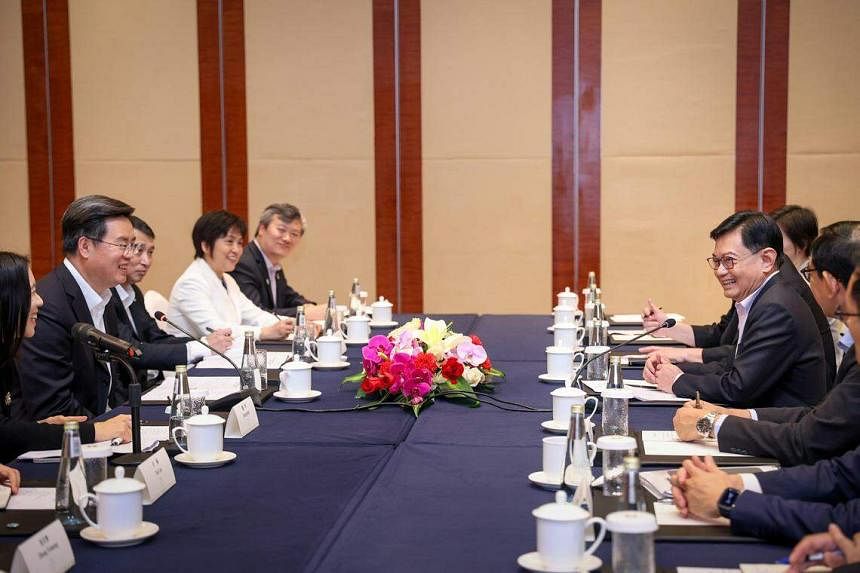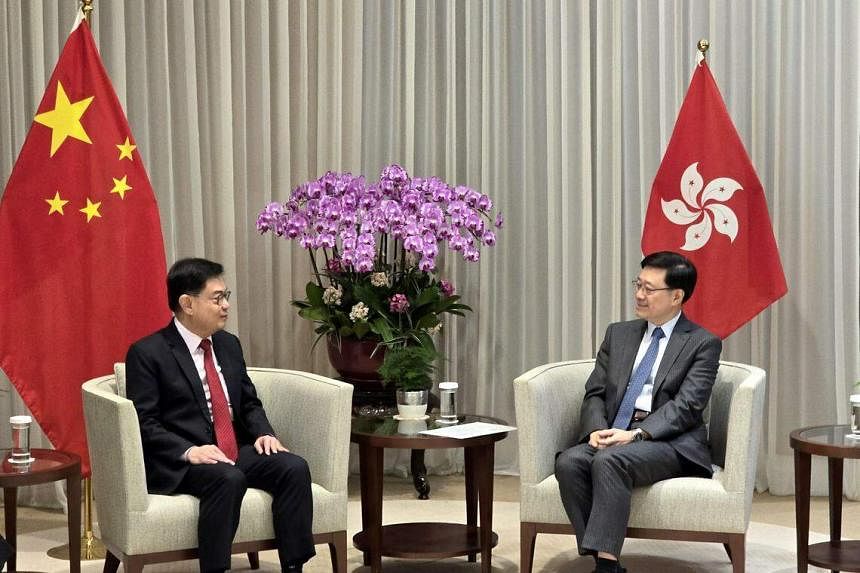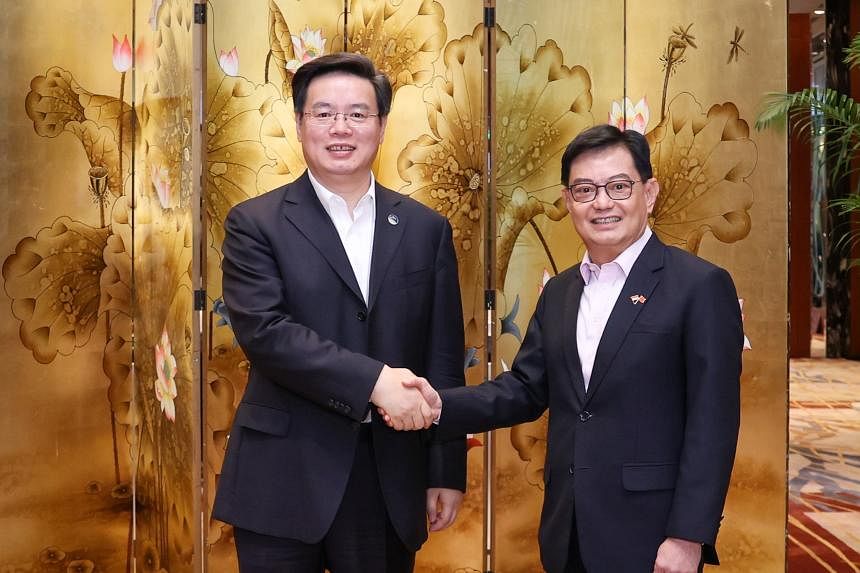BEIJING/HONG KONG – Singapore and Shenzhen should strengthen cooperation on a bilateral project that promotes cross-border digital trade and data flows, said Deputy Prime Minister Heng Swee Keat.
The Singapore-China (Shenzhen) Smart City Initiative (SCI) marks its fifth anniversary in 2024, and both sides should “take it to the next level”, DPM Heng told Shenzhen Mayor Qin Weizhong in a morning meeting in the southern Chinese tech hub on April 12.
DPM Heng, who is also Coordinating Minister for Economic Policies, is on a six-day official visit to China to explore ways to strengthen bilateral cooperation. After a series of meetings in Beijing from April 7, he arrived in Shenzhen on April 11 and made his last stop in Hong Kong on April 12.
The SCI was launched during DPM Heng’s last visit to China in 2019. It aims to strengthen digital and business linkages between Singapore and Shenzhen, with a focus on boosting digital connectivity, promoting innovation and entrepreneurship, as well as developing talent exchanges.
The project also seeks to create opportunities for companies on both sides to tap markets in the Guangdong-Hong Kong-Macau Greater Bay Area and South-east Asia.
DPM Heng described the SCI as a “very important pathfinder for cross-border digital trade and data flows”, which does so “by piloting projects to experiment with how we can do this well”.
“Innovative government policy will be necessary for us to support companies’ innovation,” he added.
Mr Qin said that while the SCI had the words “smart city” in its name, the bulk of bilateral cooperation under its ambit was focused on trade.
Mr Qin co-chairs a committee that implements the initiative, alongside Singapore’s Permanent Secretary for Communications and Information Joseph Leong.
Under the SCI, both sides are working on projects that facilitate paperless cross-border trade, such as through a mutual recognition of electronic bills of lading – legal documents accompanying shipments used in customs clearances.
A “cross-border trade big data platform”, which is to explore the exchange of trade data to improve the efficiency of two-way trade, has also been announced.

DPM Heng affirmed the strong economic relationship between Singapore and Shenzhen, a city of more than 17 million people in Guangdong province.
Trade between Singapore and Shenzhen reached about US$11 billion (S$15 billion) in 2023, up 25 per cent from the previous year, he said. This is almost half of the trade in 2023 between Singapore and Guangdong – the Republic’s top provincial trading partner in China for the last 35 years.
Many Singapore companies have also invested in Shenzhen, DPM Heng noted. Foreign direct investment from Singapore to Shenzhen amounted to about 580 million yuan (S$110.9 million) in 2023, an increase of about 50 per cent from a year earlier.
While in Shenzhen, DPM Heng visited several companies on April 11, which he described to Mr Qin as being “at the forefront of research and innovation” in areas such as financial services, advanced manufacturing and drug discovery. These include XtalPi, a technology start-up that uses artificial intelligence to discover compounds that can be developed into new drugs.
He also had dinner with a group of business executives from the city. They discussed how companies from Singapore and Shenzhen could work together on technological innovation and enterprise development, he said in a Facebook post.
In Hong Kong, DPM Heng met the city’s top leader, Chief Executive John Lee, and reaffirmed the close and longstanding relations between the two cities, discussing ways to improve cooperation.
“As global cities and financial hubs, Singapore and Hong Kong share many similarities and challenges,” DPM Heng said in a Facebook post. “There is scope for us to do more together in areas of mutual interest such as trade and investment, innovation and research, to address the many issues that are important to our peoples.”
He also expressed confidence in Hong Kong’s continued development and prosperity under the “one country, two systems” framework. This refers to the principle under which Beijing has promised Hong Kong a high degree of autonomy that lets it retain its own systems unique from that of mainland China.

Mr Lee said he was pleased to meet DPM Heng again since they last met during his visit to Singapore in July 2023.
He thanked Singapore for its continued support for Hong Kong’s early accession to the Regional Comprehensive Economic Partnership, and noted that Singapore has consistently been Hong Kong’s largest trading partner in Asean, with bilateral trade in goods between the two cities amounting to HK$394.7 billion (S$68.5 billion) in 2023.
Hong Kong would continue to make every effort to strengthen its multifaceted cooperation with Singapore, he said, particularly in green and digital economies and other emerging industries.
DPM Heng returned to Singapore later on April 12.
The six-day trip is his first to China since October 2019, and the latest in a series of high-level official exchanges between Singapore and China after bilateral ties were upgraded in April 2023.
He was accompanied by officials from the Ministry of Foreign Affairs, the National Research Foundation, Ministry of Trade and Industry, as well as the Prime Minister’s Office.
In a Facebook post on April 12 at the end of his trip, DPM Heng said he had “a fruitful work trip” and looked forward to “keeping up the good momentum of bilateral exchanges and strengthening our cooperation with China, including at the regional and global levels, for the benefit of all our peoples”.

